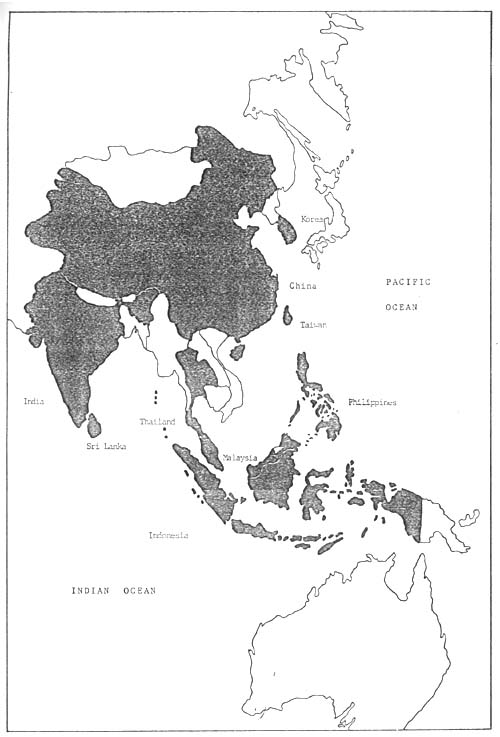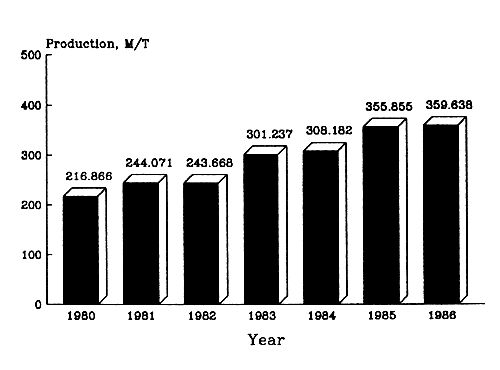Among the Asian countries, China, India, Indonesia, Republic of Korea, Malaysia, Philippines, Taiwan, Thailand and Sri Lanka are all producers of oysters (Fig. 1). The status of oyster culture in each of these countries varies considerably although most of them share the same rich pool of suitable species and environments for mariculture. Among these countries, oyster culture is particularly well developed in the Republic of Korea, which produced 268,775 MT of the Pacific oyster Crassostrea gigas in 1986, followed by China, Taiwan, Philippines and Thailand. The current output of oysters from India, Indonesia, Malaysia and Sri Lanka is minimum when compared to the extensive coastal areas suitable for culturing oysters.
In 1985 the production of oysters in China, Indonesia, South Korea, Philippines, Taiwan and Thailand totalled some 355,855 MT, (Fig. 2). This value represents over 12 % of the worlds production of molluscs in 1985, which was 2.88 million MT (FAO, 1987). Taking the Asian region, as defined by FAO, this was 17 % of the region's mollusc production which was 2.09 million MT. Compared to the total production output of the same countries in 1983, which amounted to 301,237 MT, there was a 2 % increase in 1984 and about 15 % in 1985. The production of oysters by each of the selected countries for the period 1980–1986 is shown in Table 1.
Most species of oysters under cultivation belong to the genus Crassostrea and only few belonging to the genera Saccostrea and Ostrea. The species cultured among the selected Asian countries are shown in Table 2. In China C. plicatula and C. rivularis are the two major species cultured on a large commercial scale.
One significant trend in shellfish mariculture in the region has been the establishment of bivalve hatcheries of varying sizes to meet the growing requirements for oyster seed. Since the early 1980s, pilot hatcheries have been set up in Thailand (Prachuab Khiri Khan Brackishwater Fisheries Station), Malaysia (Bivalve Hatchery Project of the Universiti Sains Malaysia), Philippines (Aquaculture Department of the Southeast Asian Fisheries Development Centre or SEAFDEC, and at the Mariculture Centre of the Philippine Human Resources Development Centre, PHRDC) and in India (Tuticorin Research Centre of the Central Marine Fisheries Research Institute or CMFRI). Although these hatcheries have been in operation for several years, oyster seed production is still minimal. Research is currently being undertaken as these facilities are considered crucial for safeguarding and further developing the oyster industry in the region.
Another recent trend is the interest among oyster producing countries in developing shellfish depuration techniques. More and more countries recognize the export potential of their shellfish resources and therefore are becoming increasingly concerned about meeting the sanitary quality standards of importing nations. Several pilot depuration plants have been set up in the region, in particular the Philippines, Thailand, India and Malaysia where health problems due to unhealthy oysters have been recorded. The depuration system widely adopted has been the recirculating type utilizing ultraviolet lamps as the source of sterilization.

Figure 1: Asian countries selected for this study: China, India, Republic of Korea, Malaysia, Philippines, Sri Lanka, Thailand and Taiwan.

Figure 2: Cumulative oyster production from China, Indonesia, Malaysia, Philippines, ROK, Thailand and Taiwan from 1980–1986. Data from table 2.
Table 1. Annual production of oysters in selected Asian countries, 1980–1986. (Values: MT).
| COUNTRY | YEAR | ||||||
| 1980 | 1981 | 1982 | 1983 | 1984 | 1985 | 1986 | |
| China | - NA - | - NA - | - NA - | 35,526 | 40,688 | 50,872 | 54,995 |
| India | - NA - | - NA - | - NA - | - NA - | - NA - | - NA - | - NA - |
| Indonesia | 1,141 | 1,131 | 1,016 | 1,041 | 1,198 | 744 | - NA - |
| ROK | 187,033 | 206,361 | 189,204 | 218,463 | 211,886 | 254,515 | 268,775 |
| Malaysia | - NA - | - NA - | 4 | 2 | 10 | - NA - | - NA - |
| Philippines | 46 | 7,757 | 19,017 | 11,469 | 14,776 | 15,485 | 16,665 |
| Sri Lanka | - NA - | - NA - | - NA - | - NA - | - NA - | - NA - | - NA - |
| Thailand | 7,677 | 8,429 | 9,225 | 8,783 | 10,582 | 8,757 | - NA - |
| Taiwan | 20,969 | 20,393 | 25,202 | 25,953 | 29,042 | 25,482 | 19,203 |
Table 2. Status of oyster culture in selected Asian countries.
| COUNTRY | COAST LINE | SPECIES | SOURCE OF SEED | CULTURE METHOD (a) | STATUS | MAJOR CONSTRAINTS |
| China | 3.2 × 10-4 km | C. plicatula (b) | Wild | B,I,S | Highly developed | Need mechanization. |
| C. rivularis | " | |||||
| C. talienensis | " | |||||
| India | 6.1 × 10-3 km | C. madrasensis | Wild, hatchery | B,I,S,R | Developing | Lack of trained personnel; limited marketss; limited seed supply for some species. |
| C. gryphoides | Wild | |||||
| C. rivularis | " | |||||
| S. cucullata (c) | " | |||||
| Indonesia | 3.7 × 10-4 km | Crassostrea spp. | Wild | B,I,S | Experimental | Lack of trained personnel; low demand. |
| Saccostrea spp. | " | |||||
| ROK | 1.5 × 10-4 km | C. gigas | Wild | B,I,S | Highly developed | ---- |
| Malaysia | 4.3 × 10-3 km | C. belcheri | Wild | B,I,S | Poorly developed | Fouling; siltation; limited seed supply; predation. |
| C. rivularis | " | |||||
| S. cucullata | " | |||||
| O. folium | " | |||||
| Philippines | 7.0 × 10-4 km | C. iredalei | Wild | B,I,S | Developed | Poor sanitation; limited markets. |
| C. malabonensis | " | |||||
| C. palmipes | " | |||||
| S. cucullata | " | |||||
| Sri Lanka | 1.2 × 10-3 km | C. madrasensis | Wild | I | Experimental | Lack of trained personnel; limited seed supply; low demand. |
| C. belcheri | " | |||||
| S. cucullata | " | |||||
| Taiwan | 1.1 × 10-3 km | C. gigas | Wild | I,S | Developed | ---- |
| Thailand | 2.6 × 10-3 km | C. belcheri | Wild, hatchery | B,I,S | Developed | Limited seed supply; limited suitable areas; poor quality control. |
| C. luqubris | Wild | |||||
| S. commercialis | " |
a: B = bottom; I = intertidal; S = suspended (raft or rack); R = relaying.
b: C = Crassostrea.
c: S = Saccostrea.